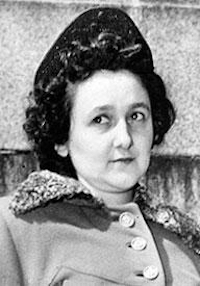Ethel Rosenberg (1915-1953), along with her husband, Julius Rosenberg, was tried and convicted of espionage for providing the Soviet Union classified information on the Manhattan Project. The Rosenbergs were executed in 1953.
Early Years
Ethel was born into a family of Jewish immigrants in New York City on September 28, 1915.
In 1931, she graduated from Seward Park High School, where she had pursued her interest in acting and singing by participating in school theatrical performances. After graduation, Ethel began working as a secretary for the National New York Packing and Shipping Company. During this time, she became an active member of a workers’ union organizing strikes and protests. She was additionally a member of the Young Communist League. Through her activism and engagement in the Communist Party, she met Julius Rosenberg in 1936. The two married in 1939.
Espionage, Conviction, and Death
Ethel’s husband Julius became involved in espionage activities for the Soviet Union by 1942. In addition to providing classified documents to the Soviet Union, he also recruited other spies, including Ethel’s brother, David Greenglass, a member of the Special Engineer Detachment at Los Alamos. In his controversial testimony against the Rosenbergs at their trial, David Greenglass reported that his sister Ethel had typed the notes her husband passed to the Soviet Union on the American bomb project.
Both Ethel and Julius Rosenberg were arrested and charged with conspiracy to commit espionage in 1950. The couple was convicted on March 29, 1951 and sentenced to death on April 5 for violating Section 2 of the 1917 Espionage Act, which prohibits providing classified information related to US national defense and security to foreign governments.
Ethel was executed, shortly after her husband, at Sing Sing Prison in Ossining, New York by the electric chair on June 19, 1953. The couple was survived by their two children, Michael and Robert Meeropol, who were six and ten years old at the time of their parents’ execution.
Consequences
The Rosenberg trial increased the growing apprehension among the American public of Soviet espionage, and fueled the anti-Communist campaigns of Senator Joseph McCarthy. Although in recent years evidence has confirmed that Julius Rosenberg was indeed a Soviet agent, other recently declassified documents have shown the strong possibility of Ethel’s innocence. It was the testimony of David Greenglass in the 1951 trial which implicated Ethel, but before a secret grand jury in 1950, Greenglass affirmed, “I said before, and say it again, honestly, this is a fact: I never spoke to my sister about this at all.” Ethel and Julius were the only American civilians executed for espionage activity during the Cold War.





